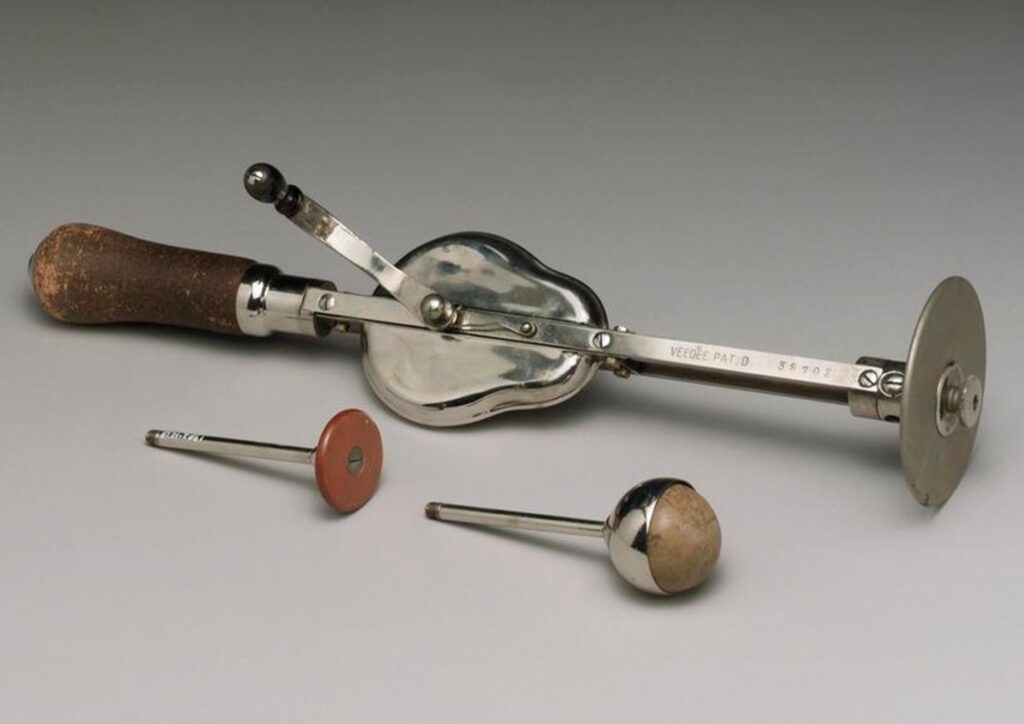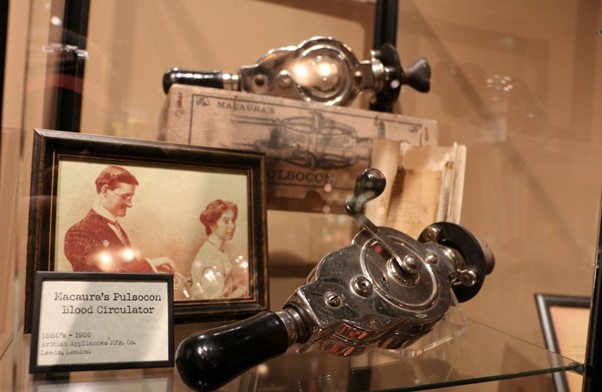Nowadays, you can’t walk past a sex shop without seeing them in all sizes, shapes (I once saw one with Karl Marx’s face engraved on it) and colours: vibrators. Whereas today they are an integral part of the bedside table and of social conversations with friends, in the 19th century they were not the symbol of sexuality as we know it today. The use of a vibrator as a sexual object was, according to various historians such as Rachel Maines, out of the question during this period, as it was mainly used as a treatment method for ‘female hysteria’. This often shared view does not appear to be irrefutable, as recent research has shown that the evidence for this theory leaves much to be desired.

Veedee vibrator with two attachments (1901-1930). Photo: Science Museum Group
According to Maines, who in her work The Technology of Orgasm: ”Hysteria”, the Vibrator and Women’s Satisfaction (1999) outlines the history of medical malpractice against female sexuality, the vibrator is the fifth household electrical appliance – thus before the vacuum cleaner – to be invented in the late nineteenth century. In her work, Maines argues that since classical antiquity, doctors have regarded reproductive sex as the norm and deviant sexual expressions have been medicalised. Maines states that, among all kinds of other treatments, a new device made its appearance in the medical world: the vibrator. Genital massage would lead to ‘hysterical paroxysm’ – the term used for what we know today as a female orgasm – in order to make hysteria disappear. This so-called hysteria was a hodgepodge of general symptoms, ranging from anxiety, headaches, nervousness and sexual fantasies to fainting and paralysis. In short, more than two-third of the women would show daily manifestations of hysteria. Maines claims that the narrative is male-dominated: female sexual expressions are shunted away as deviant and men try to control what is incomprehensible to them by medicalising it.
According to the Science Museum, the early twentieth-century German ‘Veedee’ vibrator could solve all kinds of physical ailments, such as the common cold, through ‘curative vibration’. Included in the box of this object is an instruction that states that there is virtually no ailment that this vibrator cannot solve. The museum states that around the nineteenth century, massage was considered an effective remedy for all kinds of ailments, including hysteria.
Historians Hallie Lieberman and Eric Schatzberg are critical of the hypothesis presented by Maines because there is little or no evidence of doctors using vibrators at that time for genital massage to combat hysteria. They do acknowledge that vibrators were used in the early 19th century, but state that there is no evidence for the hypothesis Maines is arguing. Maines herself says she is surprised that others are questioning her hypothesis so late in the day, because she acknowledges that she never had any direct evidence for her theory, but that people made a big deal out of it.
In popular culture, the image of the vibrator as an invention against hysteria seems to be deeply rooted. The English physician Joseph Mortimer Granville was the inventor of the portable electromechanical vibrator and is portrayed in the romantic comedy Hysteria (2011), where the image of the vibrator as a cure for hysteria is depicted.
This is remarkable, because in 1883 Granville wrote about his own research:
”I have avoided, and shall continue to avoid, the treat- ment of women by percussion, simply because I do not want to be hoodwinked, and help to mislead others, by the vagaries of the hysterical; state or the characteristic phenomena of mimetic disease.”
In the early 20th century, the vibrator as a medical device came under increasing pressure. As a result, sellers changed their strategy: it was not promoted as a medical instrument, but as a handy utensil for both men and women in the household. This concerned the use for all sorts of places on the body, such as the head and neck, and not for masturbation, because it was forbidden under US law to promote objects, such as the vibrator, as a sexual tool. Sellers therefore emphasised all other possibilities for use, knowing that sexual use was widespread. In the middle of the nineteenth century, the vibrator was promoted as a means of losing weight and keeping the skin smooth. In the two decades that followed, the first cracks in the taboo surrounding the vibrator as a sexual object became visible. From that period onwards, the sexual benefits of the vibrator were increasingly discussed in public, but with restraint. By the end of the 20th century, most of the regulations preventing sexual promotion had disappeared, so the first vibrators in bright colours and with all kinds of attachments were soon brought onto the market.
In the year 2021, the use of the vibrator as a sexual object is widely known and largely accepted in Europe and gradually more in some parts of the United States, while in some countries, such as Saudi Arabia and Malaysia, its use as such is still prohibited. TV shows speak more openly about the use of sexual objects such as vibrators, sex shops advertise in public spaces, and YouTube is full of videos comparing different models. Meanwhile, the dark colours of the monotonous vibrators of the nineteenth century have made way for striking colours, patterns and shapes in this century. This aesthetic metamorphosis is exemplary of the shifts that the object has undergone in use. What used to be a nondescript object serving to alleviate medical ailments and improve the body, changed in the twenty-first century into a symbol of sexual freedom. But for who?
The discussion around the myth of the vibrator as a remedy for hysteria provides an insight into how we as a society view (female) sexuality, intentionally or unintentionally. This myth suppresses the woman’s individuality and freedom by claiming that the woman does not understand her body and is sexually ignorant, whereby this deep-rooted bias resonates in, for example, the laws surrounding birth control and abortion in the United States. The development of the vibrator as a sexual object has many different nuances and shifts, prompting us to think about other questions: How do we perceive our sexuality in relation to objects and the way we use them? And how is that reflected in our society and our laws?
By J. Hakkert
